The guide to understanding how Skills-Based Organizations will thrive in 2024
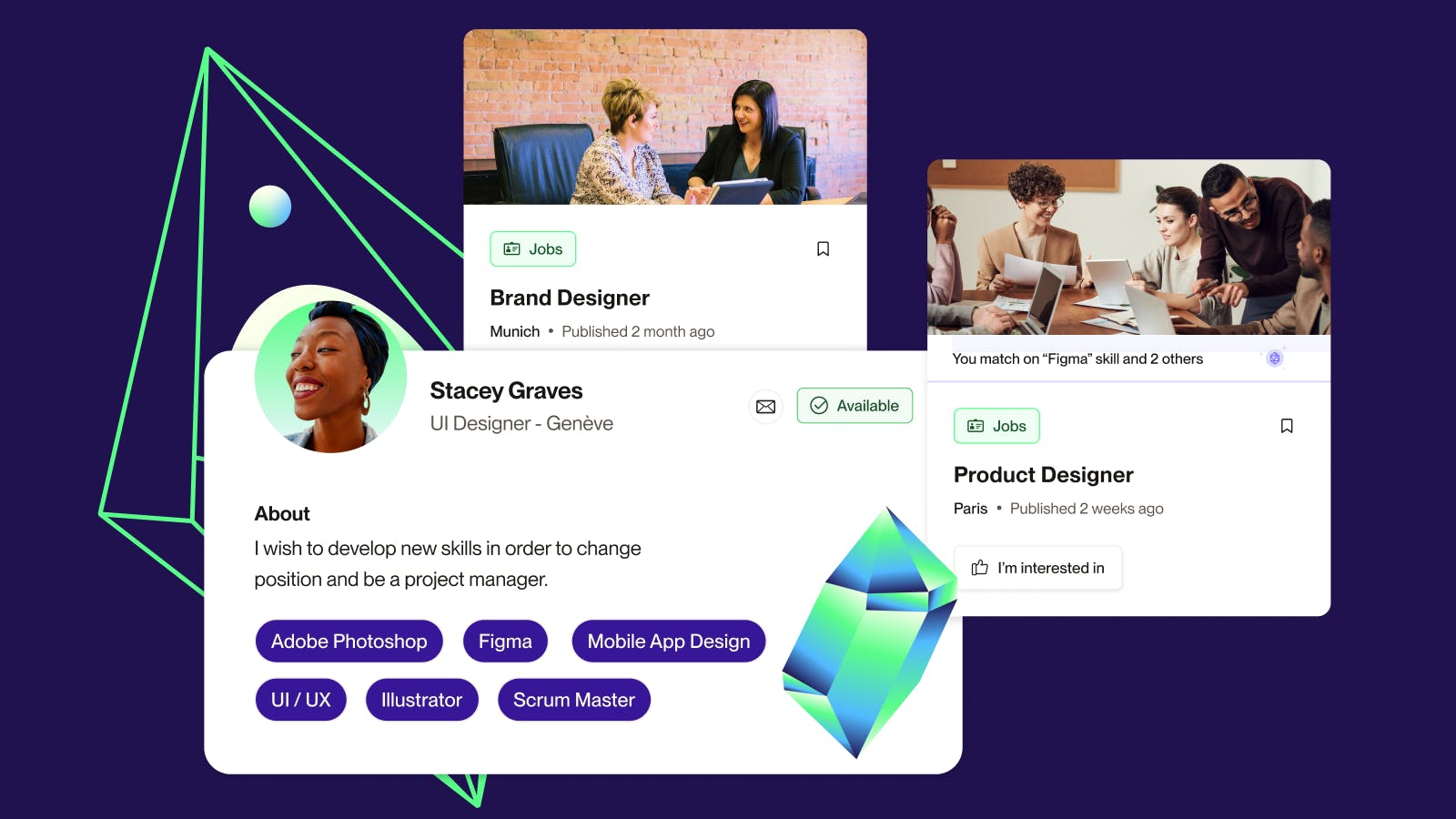
Organizations are experiencing a shift from being job-driven to skills-based. It requires a nuanced and thoughtful change management touch that allows your leaders and people to internalize the value of skills as a mindset as much as a talent management strategy.
Also known as The Big Shift, more and more organizations are willing to move towards this new operating model for work, based on people’s skills and not on their jobs.
And for good reason, as SBOs are more inclined to thrive in this disruptive world of work. Why? Skills-based organizations recognize that everyone is a talent by nature and everyone has the capacity to gain new potential, new skills, and new competencies every day. From improved retention rates to better inclusivity, SBOs promise a wealth of benefits.
But it is not so easy to understand why this shift is more crucial than ever to begin with, nor how transforming Human Resource strategies around their employees’ skills is a new way to attract, engage and retain talents.
In this guide, you’ll find the key to understanding the “why” and the “how” SBOs chart their course to success.
What is a skills-based organization?
Definition of an SBO
At its core, being a skills-based organization means going from a role or job-driven HR policy to a skills-based HR policy. An SBO puts its people and their skills at the center of its talent management strategies. SBOs make job and workforce decisions based on skills, not roles, from who does what work to performance management, compensation, and hiring.
Traditional jobs are broken down into projects, gigs, and tasks based on the skills and capabilities required to achieve them.
The deviation from a job-focused mentality means that employees are valued for their skills, contributions, and long-term potential rather than their educational background, job title, or level of seniority.
On a philosophical level, it means that HR and managers understand that any individual in your organization is not just connected to one role and one particular position at a time but is the master of a set of skills in constant real-time evolution and application. This enables HR teams to unlock the full potential of their workforce and drive long-term success.
SBOs main objectives
Number 1: An SBO approach puts skills first instead of degree requirements for jobs. This helps open opportunities to a broader talent pool with the practical experience and knowledge to do the work.
Number 2: An SBO approach is deconstructing jobs into the “work to be done.” Segmenting jobs allows you to understand what skills are needed to do what types of jobs and organize them by skills rather than traditional job descriptions.
Number 3: An SBO approach helps you have more visibility on your team's skills. This clear view fulfills internal talent opportunities through gigs and talent marketplaces. It permits companies to put the right people with the right skills for the proper mission, opportunity, or mobility.
Why are skills-based organizations more important than ever?
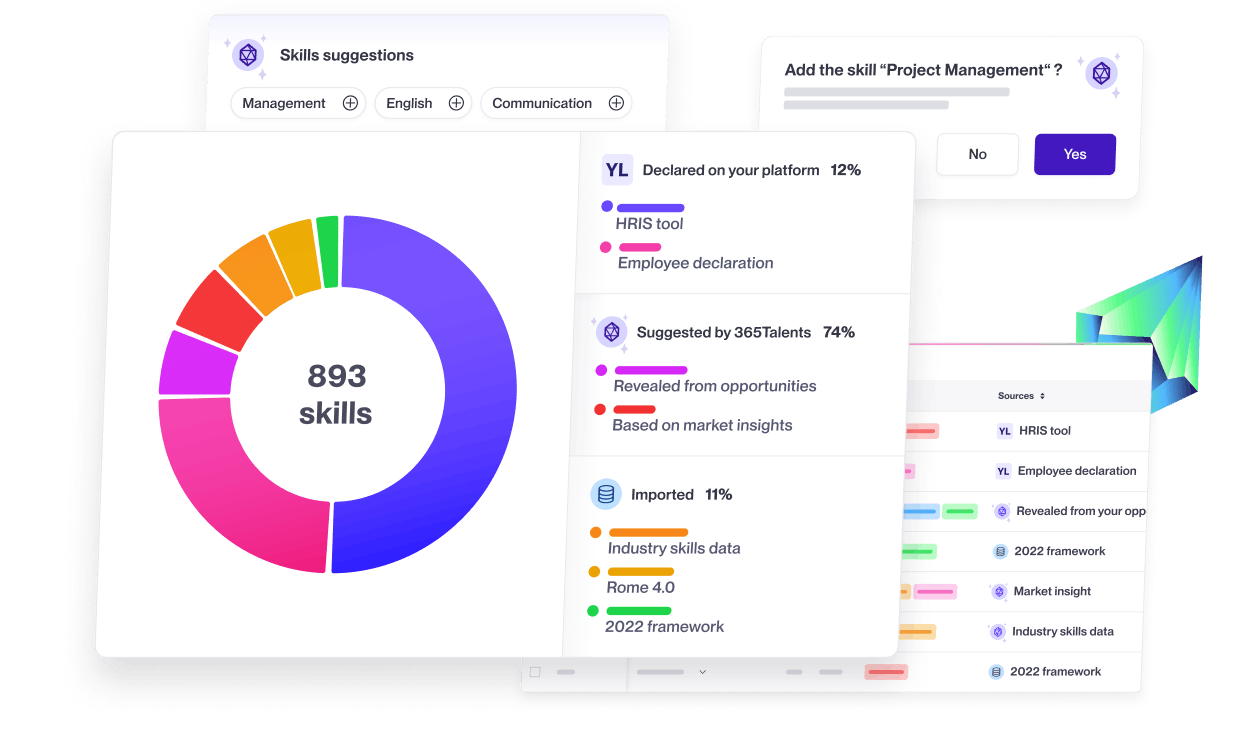
Moving towards a new agile approach
Everything happens for a reason. The past years have been significantly marked by an evolving world of work where being agile is crucial. According to a Deloitte Insights study, 77% of business and HR executives say flexibly moving skills to work is critical to navigating future disruptions.
Job titles and descriptions have defined how work is done for over a century, from hiring to career development. However, the previous organizational model needs to be updated. It’s limiting work to standardized tasks completed in functional roles and making all decisions about employees based on their position in the organizational hierarchy. The time has come for organizations to be agile, to grow alongside market needs, and to innovate their talent journeys.
In response, companies are moving to entirely new operating models for work and their workforce, focusing on skills, not just jobs.
“Our business environment is changing rapidly, and the skills needed to compete look so different than they did even five to seven years ago. Many of our people processes that HR as a profession has institutionalized for decades were built for a different, slower, much more stable environment. They weren't built for the speed and agility that our businesses require from us today.”
Deloitte
,The Skills-Based Organization Podcast
Answering market changes and workers' demands
HR professionals faced and are still facing challenges regarding talent retention and change management.
On the one hand, the famous digital transformation, including generative AI, requires new skills that employees must develop to maintain their employability on the job market. AI, especially the Generative AI peak organizations are dealing with today, pushes them to adopt a skills-first mindset and a skills-based approach. These new technologies are reshaping jobs, and how work is organized and structured.
When you think about their professional development in terms of skills, SBOs will be better prepared for the future — and the present. A skills-based HR strategy allows you to bridge skill gaps as they arise and on an individual or collective basis, as opposed to looking at them strictly when it comes to filling a need.
On the other hand, it goes the same with the talent shortages that companies face worldwide. 73% of business executives expect to continue to experience talent shortages over the next three years. But fortunately, skills also help you fill hard-to-fill roles as they open up the talent pool and help you look at jobs not as a strictly linear development but as the amalgamation of several skills. In other words, it helps you, as HR, realize the talent you have hiding behind job titles while improving your people’s employability.
Long-term employability is encouraged because thinking about skills motivates employees and HR to envision and launch growth opportunities that previously might have seemed invisible or out of line. It also helps organizations to deploy or redeploy collaborators who do some work outside of the scope of their job descriptions.
In a new world of work where the relevance of jobs is decreasing, employees want to achieve their full potential and to be seen as individuals. Still, only 26% of workers strongly agree that their employer treats them as whole individuals who can offer unique contributions and a distinctive portfolio of skills to the organization. Nowadays, employees think about new constructs for their career development and don’t see permanent full-time jobs as the only opportunities. They believe that internal talent marketplaces, freelancing, or gig work, same as the evolution of their skills - as SBOs do - over job descriptions, will better answer to their current employee journey demands.
SBOs play a key role in enabling the visibility of skills, insights into how skills mobility can help organizational objectives, and transitioning from outdated work architecture and job descriptions to skills-centric approaches.
6 main benefits of being a skills-based organization

The benefits of looking at your employees holistically through the lens of their skills and not (strictly) their job history appear endless. The impact of a skills-based approach – not only on your employees’ individual career paths and your company’s ability to anticipate and address business needs but also on the role of HR as a transformative, strategic leader – has the potential to be profound.
1. Employee engagement and retention
Skills-based organizations allow HR departments to improve engagement and retention by creating a new way of capturing information and understanding. People are seen as multi-layered and multi-faced assets – not only as one person in one role. Being skills-based allows HR to provide more opportunities more dynamically. Employees benefit from access to information and opportunities that open their eyes and help them chart their professional paths.
Moreover, employees need this visibility on their skills and potential future as individuals at your organization. They need to be able to see the paths they have access to in the company. And at the same time, your organization benefits from greater visibility of your collaborators because they have more to offer than what you would know just from their job title.
2. Internal Mobility
Driven by heightened visibility, which bolsters retention and fosters continuous engagement and growth, skills-based organizations experience a surge in internal mobility. Additionally, internal hiring proves to be more cost-effective than external recruitment, translating to immediate bottom-line benefits for the company.
3. Advantages of a Talent Marketplace Approach
Skills-based organizations leverage more efficient talent marketplaces for agile gig and project staffing. By prioritizing internal talent, companies optimize efficiency and productivity while minimizing costs associated with external resources.
4. HR efficiency
Skills-based organizations make use of skills data, which provides a better understanding of the potential profiles for any of your opportunities. Leveraging AI can also make a difference in preparing employee reviews, strategic workforce planning tasks, and company or recruitment assignments. Skills-specialized AI tools can decrease the time needed to prepare for these touchpoints or tasks and increase HR efficiency.
5. More inclusivity for DEIB strategies
“A DEIB strategy, commonly known as a DEI or diversity strategy, is an action-based plan designed to reduce disparities and create a culture of inclusion in the workplace.”
SBOs can promote diversity and inclusion in a variety of ways. For example, changing the way employees are hired means recruiters will have access to a broader and more diverse talent pool. This is especially important when many organizations struggle to find suitable candidates for open positions. Hiring for skills predicts job performance five times more than hiring for education and more than twice as much as hiring for experience.
Additionally, SBOs typically create learning and development programs that focus on long-term professional development. This means more opportunities for career advancement for employees at all levels.
6. Learning and Development
With precise insights into employee skills and competencies, along with a comprehensive understanding of available learning and development resources, organizations can achieve better alignment between supply and demand of upskilling opportunities. This optimization leads to more efficient allocation of the learning budget and improved tracking of learning content utilization, resulting in significant savings in learning tools and content budgets.
SBOs strategies: a new way to attract and retain talents
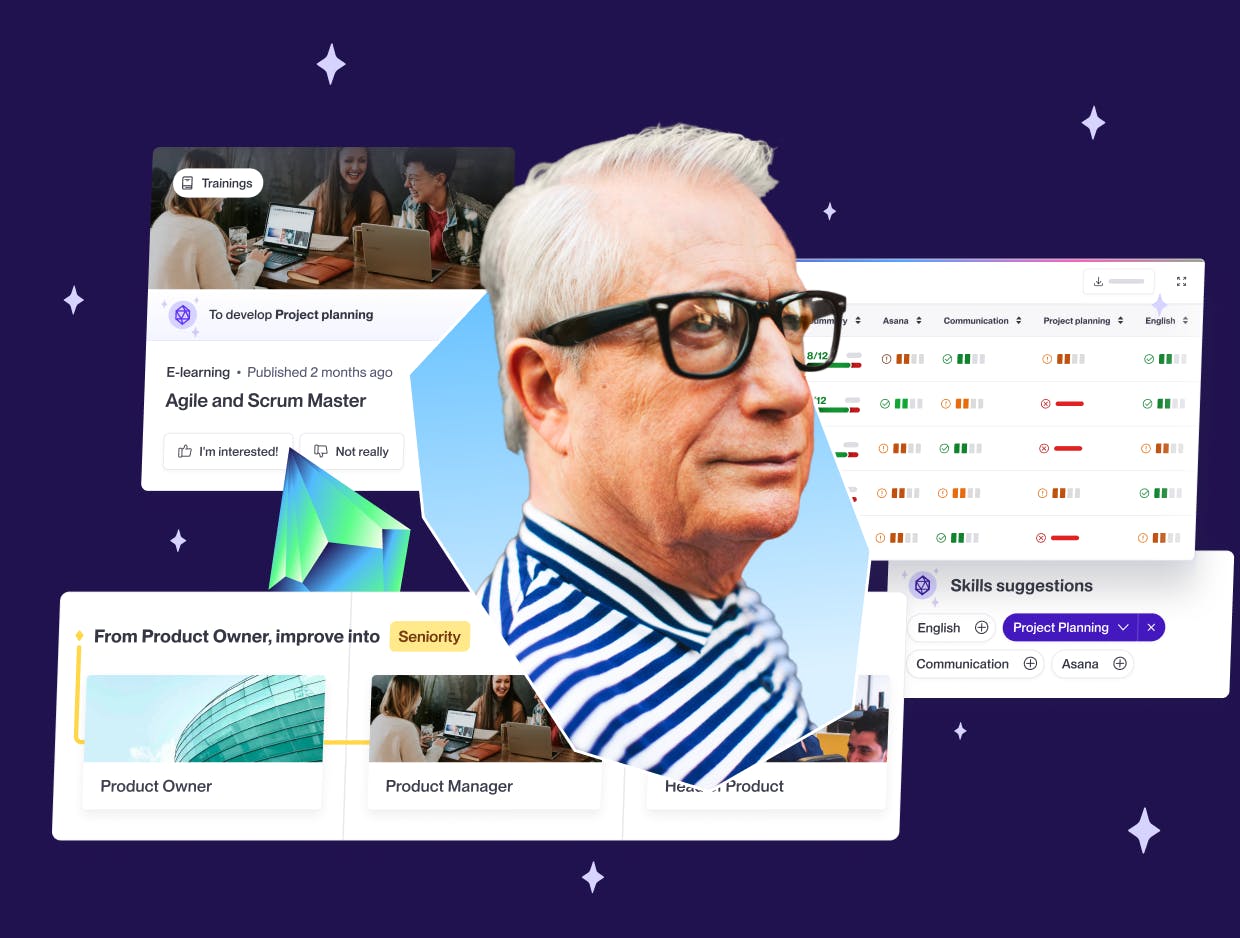
The skills-based organization is a new model for work and the workforce. It answers 3 key questions for its structure:
- What: How is the work organized? With a portfolio of fluid structures in which skills flow the work instead of jobs. It includes tasks, projects, jobs, and other attributes acquired through their experiences.
- Who: Who does the work? Employees, seen as individuals, with a unique portfolio of skills and abilities rather than seen as job titles. It includes hard skills, soft skills, mad skills, adjacent capabilities, and potential itself.
- How: How are decisions made? Organizations make decisions from hiring to retiring through the lens of skills rather than jobs. It includes everything from Talent acquisition and development, careers, learning and development, performance management, workforce planning, work and skills architecture.
These three points help companies build strategies to attract and retain their talents through the whole talent experience.
Skills-based hiring
“Is the end of the resume near?” Jan-Willem Nieuwenhuys from Digital Skilled Professionals asked. A recent study from TestGorilla stated that 86% of candidates say they are more likely to secure their dream job when given the chance to demonstrate their skills during hiring.
Good news: building a skills-based organization will help you develop a new, more agile approach towards hiring and operations management.
“Skills-based hiring is transformative. It not only ensures an equitable process but also has the ability to enhance the quality of hires made.”
Skills-based hiring unlocks dream career opportunities and has plenty of advantages:
- Expanding your network of candidates, often locating internal staff that may be a perfect fit for a job.
- Increasing employability: According to the same TestGorilla study, “66% of employees say they have gained access to new employment opportunities through skills-based assessments”.
- Making employees happier and more motivated, as 38% of skills-based hires are pleased in their role, compared to 28% of experience-based hires.
- Reducing bias as it breaks organizational silos by helping minority candidates. Companies can find people with excellent skills to fit the roles opened without looking at the name, gender, and academic degree on the resume. 73% of Asian and Arab employees and 75% of Black employees accessed new employment opportunities through skills-based assessments
To achieve this, organizations must make changes in three key areas:
1. Job listings
2. Hiring criteria
3. Assessment processes
You can find the details in our Skills-based organization benefits article here.
Reforming your hiring practices can lead to change and growth in every aspect of your business. And it shows to be worth it since 56% of employees would like to see the adoption of skills-based hiring methods increase in the next 12 months. Companies understand that vision with 73% of companies using skills-based hiring, compared to 56% in 2022.
Skills-based career development and growth
When you have a more precise knowledge of the skills and competencies of your people and your learning and development catalog, you can benefit from better matching between the supply and demand of learning and upskilling opportunities. This allows you to optimize your learning budget and track the use of your learning content for significant savings in your tools and content learning budgets.
For your employees' career development and growth, SBOs usually deploy talent marketplaces and internal mobility tools to promote gig work, career growth, and talent mobility.
They, in fact, help to reorganize work as a portfolio, show employees more opportunities based on their skills and preferences, and match them to suitable projects as per their unique skills set, interests, career goals, etc. Employers are increasingly aware that employees seek opportunities to upskill, reskill, and expand their career horizons.
51% of employees have changed from one department or profession to another in the last 12 months. This means an employee might pursue work within a different team, participate in a cross-functional project that would benefit from their expertise, or deprioritize some aspects of their day job to work on more urgent, short-term assignments.
The benefits of skills-based career growth include staff optimization, improved employee satisfaction, and better workforce collaboration. In addition, organizations can quickly address skills gaps, reduce hiring costs, and mitigate the risks posed by today’s disruptive and fast-paced environment.
Skills-based strategic workforce planning (SWP)
The switch to a skills-based approach also has the added benefit of providing the company with diverse skills data for workforce planning.
To understand workforce planning first, we would like to use “Maslow's Pyramid of Strategic Workforce Planning.”
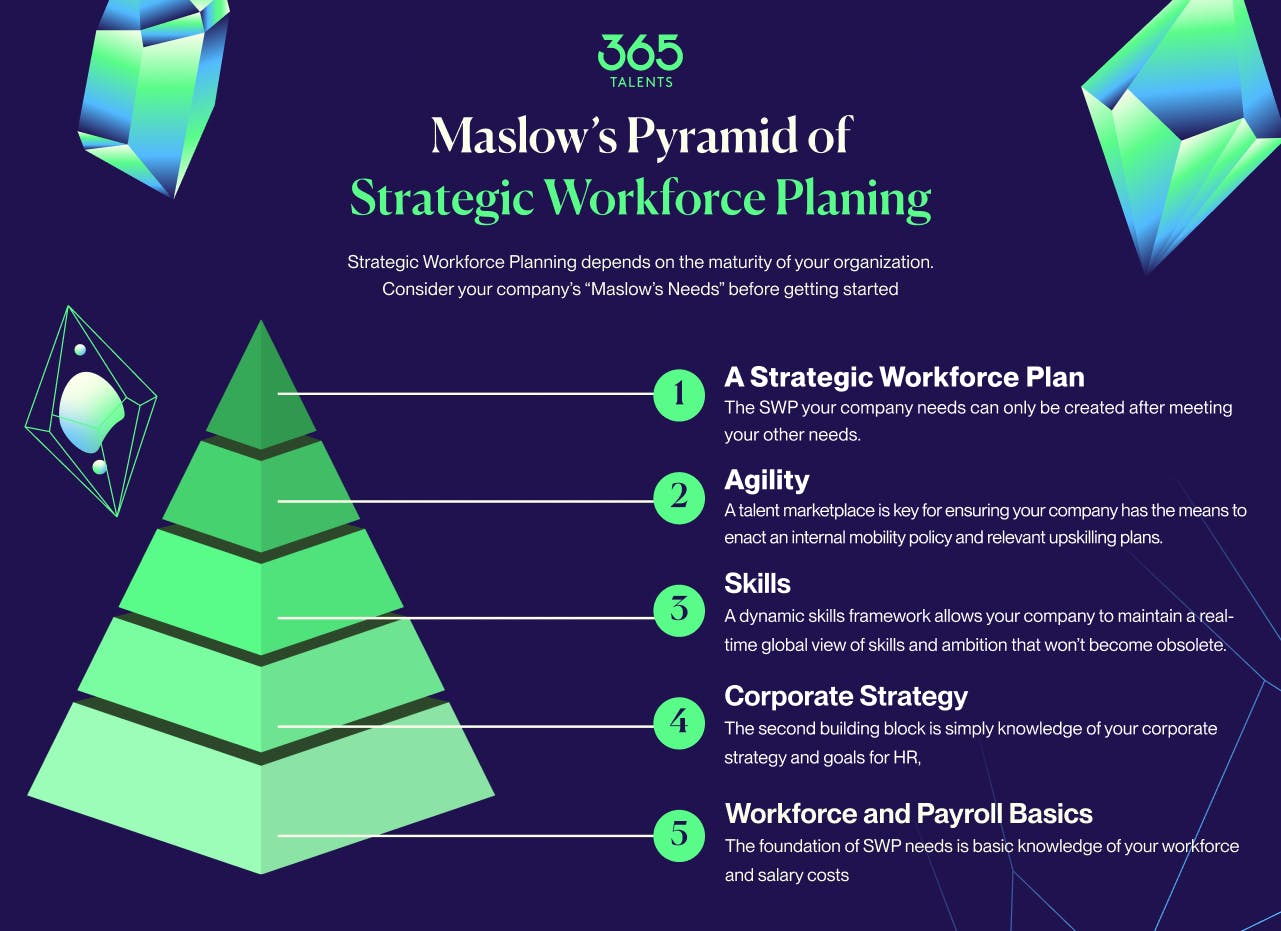
But instead of planning how many people to hire, you can now plan skills. It's essential to understand not only what skills your employees currently have but also which ones your company needs to get to bridge skill gaps, answer market-evolving demands, and respond to your employees' needs and ambitions for their careers. You can ask yourself:
– What skills are missing in my company today?
– What skills should be provided in the medium and long term for market and employees’ needs?
Skills-based workforce planning is a gem to empower your existing workforce, better prepare your people and your organization for the challenges of tomorrow, and move quickly and confidently toward the future with flexibility.
Skills-based Talent management and Talent experience
SBO companies now organize talent experience around their employees’ skills. From talent acquisition and talent management to talent development, skills-based talent practices are defining their career objectives instead of job titles history.
This is a departure from the widespread reliance on proxy signals of skills, such as four-year college degree requirements, specific number of years of experience, or a limited set of job titles in a candidate’s career history...
Jobs For the Future
,Skills-Based Practices: An Employer Journey Map
Examples of skills-based talent practices include:
• Rewriting job descriptions to focus on required skills and deleting unnecessary degree requirements
• Partnering with local community colleges or training programs to access new employees who have completed specific types of training
• Requiring managers to consider internal talent for new roles before posting jobs externally
• Providing managers and employees with information about possible career paths, the skills those paths require, and resources to develop said skills
Yesterday’s talent practices won’t meet today’s and tomorrow’s business needs. Skills-based talent practices for recruiting, hiring, developing, and promoting employees offer way more benefits than job titles-based talent practices:
- Giving employers access to a larger internal talent pool
- Matching business needs with the right talent, their skills and ambitions
- Accelerating diversity, equity, and inclusion efforts by providing HR with access to untapped talent without bias and other barriers
- Helping HR to make skills-based hiring decisions, reducing costs
- Improving employee satisfaction and loyalty by showing them new career opportunities, personalized to their skills, needs, and demands.
- Charting new courses for people at work by empowering them for their own career paths.
Building your talent experience around skills helps your employees to develop additional competencies required to fill new roles. This proves beneficial to both employees and employers.
You can chart career paths based on skills opportunities, meeting specific business needs and future requirements while increasing retention. Companies can save up to 70-92% per employee by building new skills instead of hiring new talent.
Focus on Talent Management activities
There are various ways to ensure talent management activities are centered around skills.
This includes:
- Investing in L&D programs that focus on skills development rather than job tasks
- Developing skills-based compensation policies
- Making skills development and its focus on performance reviews
- Linking skills development to promotions and pay rises
- Providing opportunities for on-the-job hands-on learning.
None of this will be possible or easy without a skills management tailored to your company.
Skills management is a process that aims to identify, assess, develop, and align employee skills with corporate objectives.
It goes beyond the simple assessment of qualifications and experience, including people's behavioral, technical, and interpersonal skills. The ultimate aim is to secure visibility, ensuring every employee has the skills required to successfully accomplish their assigned tasks, in line with the company's overall strategy.
By investing in the skills development of its employees, a company can improve its overall performance, strengthen its competitive edge, and create a culture of continuous learning.
With the right skills management strategy, a company can attract, retain, and develop the talent needed to succeed in an ever-changing business environment.
Ready to discover a more efficient and effective skills management methodology? Reach out to the 365Talents team today and chart a new course for people at work.








How skills management looks like:
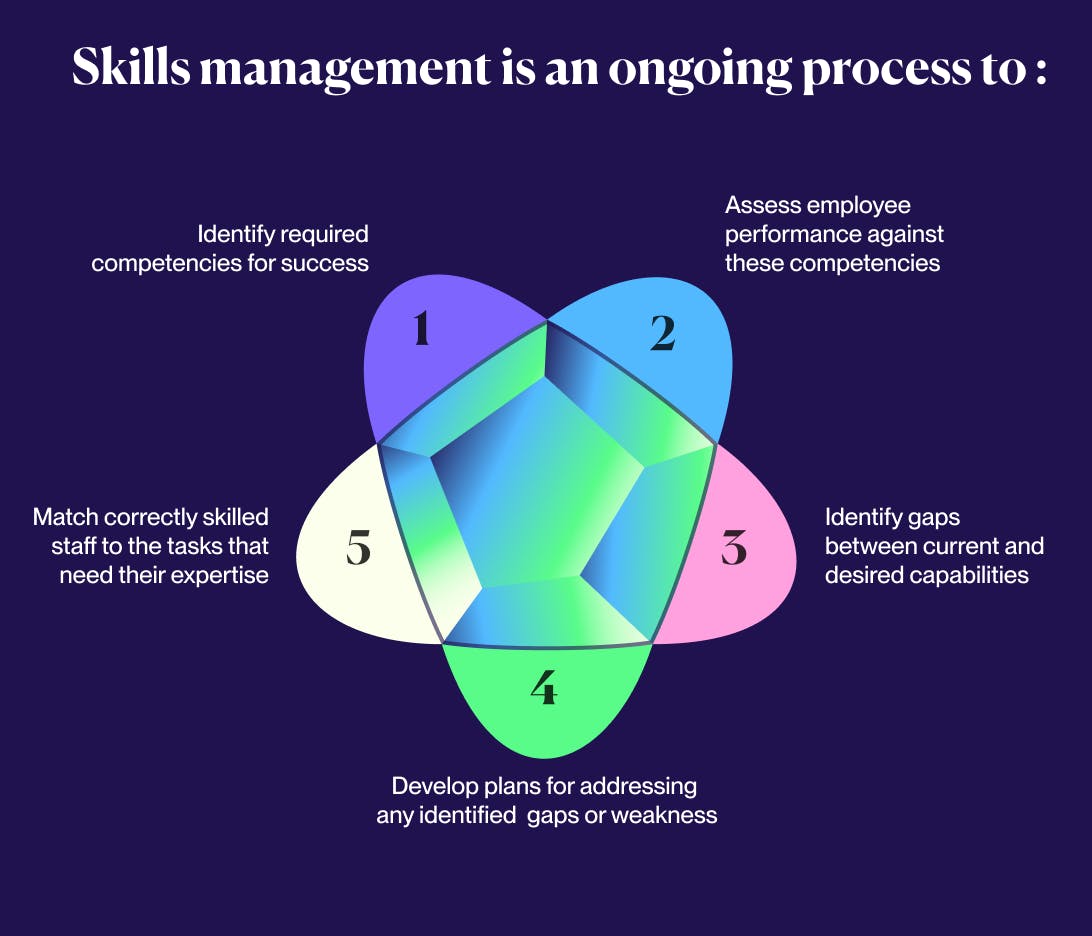
Skills hub: the center of your skills-based organization’s strategy
Great news: you finally opted for a skills-based approach for your organization. Bad news: how to operationalize it?
You need what we call a skills hub. It’s at the core of SBOs strategy’s success, and when correctly centralized, it empowers you to:
- Share a skills-based talent vision across your company: The switch from a jobs-based to a skills-based strategy embraces “skills-first” as a mindset more than simply an approach. While strategy and approach can be directed top-down, mindsets come from within and, at scale, enjoy the unique power of a grassroots movement. It requires a shared outlook across the organization regarding the value and prioritization of skills “as the connecting thread of talent management” and how they will direct all workforce decisions.
- To do this, you need to deeply understand, internalize, and communicate the value of skills so that your company adopts it not just as a strategy, but as a way of thinking about the world of work.
- And it seems like it works, as 63% of business and HR executives already say their organization’s business and HR executives are aligned on the importance of skills in making decisions. It is now easier for companies to understand and implement this skills-based talent vision.
- Establish skill governance: Skills governance is skills management at the global level, and represents both the overarching principle and the organizational structure that dictates how the company will strategically address skills management.
- In essence, skills governance is the “who” of skills management, which can either be centralized or decentralized. Who will own the transformation to a skills-based organization? The CHRO and the HR team largely lead centralized skills governance. While this has advantages, it can prove challenging for implementation if the strategy needs to be better understood or communicated to business leaders and stakeholders in each business division or geography.
- Decentralized skills governance is when leaders lead skills management from each business line. Similarly, advantages exist here (such as subject matter expertise), but may need to gain the big-picture vision and strategy that HR contributes.
- The best approach for most organizations, then, is that of hybrid skills governance, where skills management is centralized on a technological level for strategic vision and driven by an influx of real-time internal data on the business, but decentralized operationally with insights shared back to each business leader and line to guide everyday plans and operations.
- This transformation goes beyond HR, as “90% of business and HR executives say moving to a skills-based organization will require a transformation for all functions and leaders, not just HR. “
- Skills data powered by technology: New technologies arrived on the market with AI-powered skills assessment and frameworks, making SBOs success possible. HR softwares based on skills match skills to work, career opportunities, teams, and learning. It analyses skill gaps from all data collected to inform HR teams and managers what skills they need to develop or hire (internally or externally).
Why should you capture skills data?
Skills tech and the data it presents are essential in every HR process. This information provides HR teams with an overview of the current skill sets within their organization, informing:
- Who we hire: if a candidate has the necessary skills to add to the team’s existing skill set and close any known skills gaps.
- How much we pay them: the candidate or employee’s position within the salary grid based on their skills and competencies.
- Who we promote: if an employee has upskilled and is now eligible to progress into a new role.
- How and where we deploy skills across the organization: leaders can distribute relevant talent into new roles or specialized projects based on skills.
- How we grow our business: tracking skills enable decision-makers to plan expansion into new business areas or markets.
Fortunately, there are some fantastic tools powered by AI to help you gather all your skills data into one place of truth.
Choosing the right Skills Tech tool
Skills tech zones in on the specific tools used to support employee learning and development, such as skills assessment and learning management systems. There is a degree of overlap, but essentially, skills tech is a specific area of your HR tech stack that will enable employees to acquire new skills and advance their careers.
Whatever HR tool you choose, your skills technology needs to operate on three levels:
- Employee engagement
- Offer-and-demand matching
- Decision making
You need a tool that identifies and captures skills expressed across multiple solutions and sources, centralizing this data into strategic frameworks, actionable insights, or matching/staffing suggestions. Meanwhile, your employees can enjoy a more personalized HR experience thanks to intelligent career, opportunity, and skills suggestions for their professional future.








It starts with:
1) Gathering existing data from various departments and roles, with AI.
2) Centralizing all this data into a unified tool. Enhance organization and visualization.
3) Elevating the system by adding intelligence with new insights, which can be related to employees, market benchmarking, or other aspects. Make your goals attainable with smart technology designed for talent marketplace, career planning, and analytics, highlighting essential skills and skill gaps insights for data-driven decisions.
[The skills technology you bring in your company] has to be intelligent and agile enough for your employee engagement. [Your employees] have to be able to engage, fill in information, and express themselves the way they want.
LOÏC MICHEL
,365Talents CEO and co-founder
How 365Talents AI fueled by Skills Intelligence helps SBOs to thrive
Our Talent experience solutions are fueled by skills intelligence and are the right tools for SBOs who want to thrive.
365Talents helps you to create unique, accurate, and concise skills frameworks that align with your organization's specific skills context and culture. The frameworks are designed to be accurate, tailored to the particular abilities of your employees, and constantly updated to meet HR use cases and stay in sync with the latest trends. They are also designed to be dynamic, operating seamlessly within the flow of work, making them an invaluable tool for HR professionals. Most importantly, skills data should be accessible to all other HR processes and systems, serving as a common language for Talent Management and Talent Experience.
To achieve these objectives effectively, we use both top-down and bottom-up approaches to help you build a specific skills framework. Imagine your skills framework like a Tetris game board.
Your framework is a fusion of various sources that, through smart and strategic interpretation and manipulation, can be fit together for a seamless, rock-solid view of your company’s current skills.
No matter the shape, size, or quantity of the skills data you currently have, we can integrate additional data or complement it with our existing frameworks, filling in any gaps you might have and mirroring your historical approach.
Once everything is live, you have your centralized and dynamic skills framework. Our technology takes over, performing automatic categorization, synonym detection, semantic matching, language detection, and automatic translation.
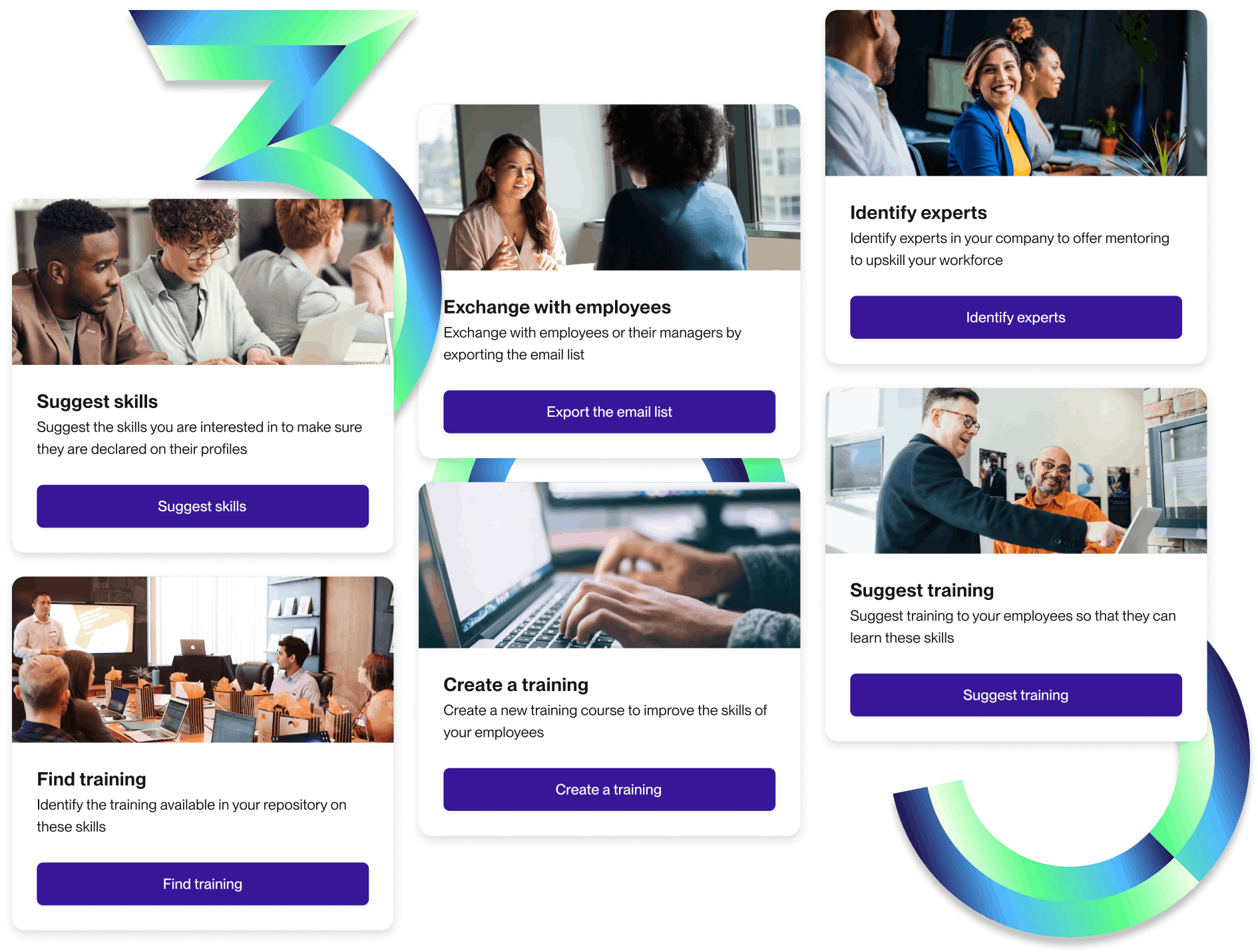
1. Skills identification with job description
365Talents relies on 3 main pillars for skills identification:
- Strong AI analysis trained on zillions of HR data
- Internal benchmarks with our in-house datasets and frameworks for reference
- External benchmarks supported by generative AI
2. Skills identification and matching from LMS
In addition to identifying skills for your skills frameworks, we go beyond by uncovering skills from your entire learning catalog on your Learning Management System (LMS).
By leveraging our expertise and utilizing over 10 integrations with top-tier LMS platforms, we can extract valuable skill information better than any LMS. This allows us to match these skills with your existing talent pool and vice versa. This holistic approach ensures a comprehensive understanding of your organization's skill landscape and enables effective talent management and development initiatives.
3. Skills and collaboration tools
Our advanced system can detect skills wherever work happens, be it on platforms like Slack, Teams, or any other collaboration tool utilized by your employees. With our robust integrations, especially with Microsoft, we offer the most cutting-edge solutions available on the market.
4. Skills and matching for Talent Marketplace
As the leading talent marketplace in Europe based on Enterprise clients' project execution and number of go-lives, our platform excels in skill detection and precise employee matching for job opportunities, projects, and other assignments. By leveraging our advanced algorithms and comprehensive skill data, we ensure that employees are connected with the right opportunities, maximizing their potential and contributing to organizational success.
5. Model Matching with Learning
365Talents seamlessly integrates with all major Learning Experience Platforms (LXP) available on the market, enabling us to detect skills and match them with the specific needs of employees. By linking our platform with LXPs, we access a vast repository of training resources totaling more than 500 million training sessions. This integration empowers organizations to leverage these extensive training options and ensure employees receive the skills development opportunities that align with their individual requirements.
6. Skills hub and single source of truth
Our skills management technology stands out as the only solution that offers effortless data management and serves as a centralized skills hub for your organization.
All sources with skills data are integrated to make up your skills framework: From employee skills declaration, HR or managers additions, AI extract from opportunities, official frameworks like ESCO or ROME, to all skills detected in other systems or even benchmarks for your industry. The result is a simple point of truth that you can connect to all your other HR tools to share skills data, bring consistency, and create a common language.
By leveraging our technology, organizations can efficiently manage and leverage their skills data, empowering strategic talent decision-making and driving organizational success.
7. Dynamic skills taxonomy and automatic curation
With our innovative Skills Central, data curation becomes a breeze, allowing for easy and efficient management of your skills data. Our AI-powered tools assist in curating and analyzing the data, simplifying the process and saving valuable time and resources.
By implementing the Skills Central, organizations can experience a significant 50% reduction in data curation efforts, enabling them to focus on leveraging the insights to drive business decisions
8. Skills models trained on large volumes
Our skills models are unparalleled experts in skill detection and contextual understanding, as they are trained on billions of job offers each month. This extensive training ensures their ability to recognize and interpret skills accurately, considering the specific context in which they are used.
With models trained on over 100 billion jobs annually and supporting 45+ languages, we provide a comprehensive and multilingual solution for skill analysis and matching across diverse industries and sectors.
9. Skills gap analysis and extensive talent intelligence
With our Workforce Intelligence solution, we provide a genuine source of insight to help you understand the evolving trends in emerging and declining skills within your market. Our comprehensive platform equips you with the necessary tools to gain valuable intelligence on the talent landscape that will enable you to make proactive decision-making and strategic workforce planning.
By leveraging our Talent Intelligence capabilities, you can stay ahead of skills gaps and make informed decisions aligned with the changing skill demands of your industry.
10. Skills Aggregating capabilities
Our platform serves as a comprehensive Skills Hub, seamlessly integrating with various HRIS systems to facilitate easy management of your skills ontology and analytics. With our extensive range of integrations, we provide a centralized solution for curating and organizing skills data.
Ready to make your SBOs thrive this year? Learn more about our technology skills data here and book a demo today!
More articles on the topic...








